CED M2 Chronograph Review
By Bryan Chatwell
Competitive Edge Dynamics has been making a name for themselves for a long time, and rightfully so. If you are currently searching for a chronograph that is easy to use and comes at a reasonable cost, consider the CED M2. The M2 is the latest model from CED, and from my understanding much more user friendly that the original M1. The CED M2 is easy to set up and is not very picky about outside conditions. This is an improvement over the CED M1 and other chronographs I have used in the past.
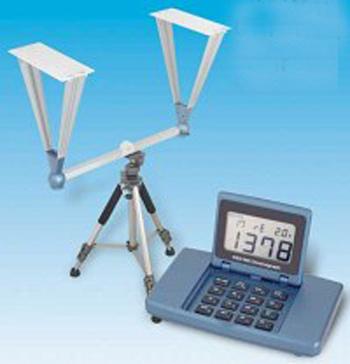
The CED M2 is lightweight and compact. The carrying case is only 19"x7"x6" and the overall weight is under five pounds. The carrying case is well thought out and the parts of the chronograph fit in their pockets easily and without any crowding or tangling issues.
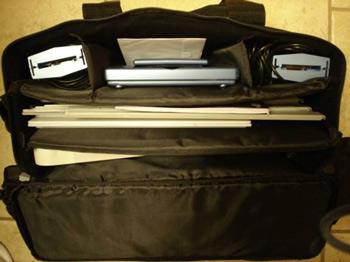
The outside of the case features two loops to carry your tripod. This is a great idea: attach your tripod to the case, and when you need your chronograph, just grab the carrying handle and you have one small package small enough to set in your floorboard.
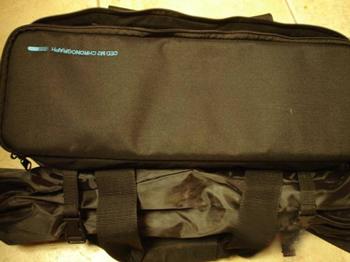
Before putting the CED M2 into service, a 9 volt battery and a tripod must be purchased. One 9 volt battery goes into the main unit and is good for approximately months of field use according to CED. As for the tripod, any adjustable camera tripod should work just fine. The particular tripod that I purchased was around twenty five dollars, adjustable from two to six feet and seems to work well. Putting the chronograph together is simple and can honestly be done without instructions, just the overall picture on the box. When putting the chronograph together, be sure not to miss the adjustment screws under the screen sensors.
The adjustments allow you to tighten the screen sensors down to their mounting bracket. If the sensors are not nice and tight, muzzle blast will cause the screens to shake and can cause false readings. False readings can also be caused by setting the chronograph up too close to the muzzle of the rifle. CED states that a good rule of thumb is ten to twelve feet away from the muzzle for rifles. The full twelve feet is definitely needed for rifles with muzzle brakes. The excess gas downrange can really shake the screens, potentially causing false readings.
According to CED, If the muzzle blast reaches the first sensor before the projectile, your results may be in error or not recorded at all. If the muzzle blast causes your screens to shake, the readings could also be affected. Suggestion - when using high powered rifles move back away from the chronograph sensors (12 - 18 feet), until proper velocities are recorded, and then move forward one foot at a time, to determine the closest distance at which each weapon will perform at. Then record that information for future use. Different calibers, brands, barrels, and ammunition will affect the distance, so it may be necessary to test each accordingly.
False readings or E0 / E1 readings can occur when the muzzle blast triggers the sensor in addition to the projectile itself.
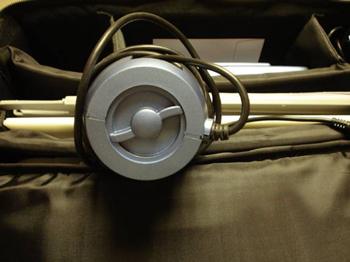
During the testing period of the CED M2, weather was terrible: overcast skies, cold and a steady wind of fifteen mph. Some past experiences with other chronographs during overcast skies have been less than great. However, the CED M2 performed very well, and the only inconsistencies were caused by shooter error. The sensor screws were not tight and the chronograph was set up too close to the muzzle of a 300rum with a custom brake. Once these setup mistakes were cleared up, the CED M2 performed as well as anyone could hope. The computer was easy to use, and the numbers were big enough to be read easily without breaking your cheek weld.
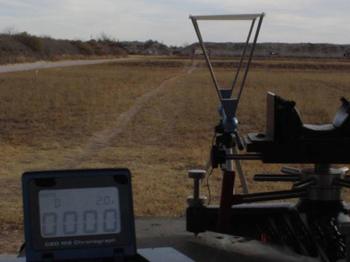
The keypad is marked in an understandable fashion and the owner's manual does a great job of going over the keypad step by step. This really cuts down on range time since time is spent shooting, not reading through a technical manual.
All the information stored in the CED M2 can be downloaded onto a computer. This is done through a USB port and a CD that prepares the computer for downloading. Once the CD is downloaded onto the computer, hook the CED M2 main unit up through the USB port and begin downloading. The CED M2 will hold up to one thousand shots in different strings of up to five hundred shots. Each individual shot and the string of shots it was in can be brought up and reviewed.
The last and possibly the most important feature of the CED M2 is that every part is replaceable and some parts can be upgraded. While the factory screens worked very well in low light conditions, infrared screens can be bought that will work indoors as well as in zero light conditions. The infrared screens require 110 - 240V AC connection to drive them. Or, a rechargeable battery pack which will give you up to 8 hours of continuous range use before recharging.
When using the normal sunlight screens which come with the chronograph set, mother nature provides the power from the sun itself and in those cases, ONLY the 9V is needed to run the CPU Main Unit and display. After seeing how well the factory screens work, I am sure that the infrared screens will live up to this claim. Only time will tell how well these new chronographs will hold up, but anyone looking for a high quality chronograph at a good price should really consider the Competitive Edge Dynamics Chronograph.
Bryan Chatwell is a Firefighter Paramedic in west Texas and a father of two incredible children. Long range hunting is something he enjoys, as is shooting F-class matches. He personally believes that F-class matches are a great way to learn almost all the skills needed for long range hunting.
By Bryan Chatwell
Competitive Edge Dynamics has been making a name for themselves for a long time, and rightfully so. If you are currently searching for a chronograph that is easy to use and comes at a reasonable cost, consider the CED M2. The M2 is the latest model from CED, and from my understanding much more user friendly that the original M1. The CED M2 is easy to set up and is not very picky about outside conditions. This is an improvement over the CED M1 and other chronographs I have used in the past.

The CED M2 is lightweight and compact. The carrying case is only 19"x7"x6" and the overall weight is under five pounds. The carrying case is well thought out and the parts of the chronograph fit in their pockets easily and without any crowding or tangling issues.

The outside of the case features two loops to carry your tripod. This is a great idea: attach your tripod to the case, and when you need your chronograph, just grab the carrying handle and you have one small package small enough to set in your floorboard.

Before putting the CED M2 into service, a 9 volt battery and a tripod must be purchased. One 9 volt battery goes into the main unit and is good for approximately months of field use according to CED. As for the tripod, any adjustable camera tripod should work just fine. The particular tripod that I purchased was around twenty five dollars, adjustable from two to six feet and seems to work well. Putting the chronograph together is simple and can honestly be done without instructions, just the overall picture on the box. When putting the chronograph together, be sure not to miss the adjustment screws under the screen sensors.
The adjustments allow you to tighten the screen sensors down to their mounting bracket. If the sensors are not nice and tight, muzzle blast will cause the screens to shake and can cause false readings. False readings can also be caused by setting the chronograph up too close to the muzzle of the rifle. CED states that a good rule of thumb is ten to twelve feet away from the muzzle for rifles. The full twelve feet is definitely needed for rifles with muzzle brakes. The excess gas downrange can really shake the screens, potentially causing false readings.
According to CED, If the muzzle blast reaches the first sensor before the projectile, your results may be in error or not recorded at all. If the muzzle blast causes your screens to shake, the readings could also be affected. Suggestion - when using high powered rifles move back away from the chronograph sensors (12 - 18 feet), until proper velocities are recorded, and then move forward one foot at a time, to determine the closest distance at which each weapon will perform at. Then record that information for future use. Different calibers, brands, barrels, and ammunition will affect the distance, so it may be necessary to test each accordingly.
False readings or E0 / E1 readings can occur when the muzzle blast triggers the sensor in addition to the projectile itself.

During the testing period of the CED M2, weather was terrible: overcast skies, cold and a steady wind of fifteen mph. Some past experiences with other chronographs during overcast skies have been less than great. However, the CED M2 performed very well, and the only inconsistencies were caused by shooter error. The sensor screws were not tight and the chronograph was set up too close to the muzzle of a 300rum with a custom brake. Once these setup mistakes were cleared up, the CED M2 performed as well as anyone could hope. The computer was easy to use, and the numbers were big enough to be read easily without breaking your cheek weld.

The keypad is marked in an understandable fashion and the owner's manual does a great job of going over the keypad step by step. This really cuts down on range time since time is spent shooting, not reading through a technical manual.
All the information stored in the CED M2 can be downloaded onto a computer. This is done through a USB port and a CD that prepares the computer for downloading. Once the CD is downloaded onto the computer, hook the CED M2 main unit up through the USB port and begin downloading. The CED M2 will hold up to one thousand shots in different strings of up to five hundred shots. Each individual shot and the string of shots it was in can be brought up and reviewed.
The last and possibly the most important feature of the CED M2 is that every part is replaceable and some parts can be upgraded. While the factory screens worked very well in low light conditions, infrared screens can be bought that will work indoors as well as in zero light conditions. The infrared screens require 110 - 240V AC connection to drive them. Or, a rechargeable battery pack which will give you up to 8 hours of continuous range use before recharging.
When using the normal sunlight screens which come with the chronograph set, mother nature provides the power from the sun itself and in those cases, ONLY the 9V is needed to run the CPU Main Unit and display. After seeing how well the factory screens work, I am sure that the infrared screens will live up to this claim. Only time will tell how well these new chronographs will hold up, but anyone looking for a high quality chronograph at a good price should really consider the Competitive Edge Dynamics Chronograph.
Bryan Chatwell is a Firefighter Paramedic in west Texas and a father of two incredible children. Long range hunting is something he enjoys, as is shooting F-class matches. He personally believes that F-class matches are a great way to learn almost all the skills needed for long range hunting.

